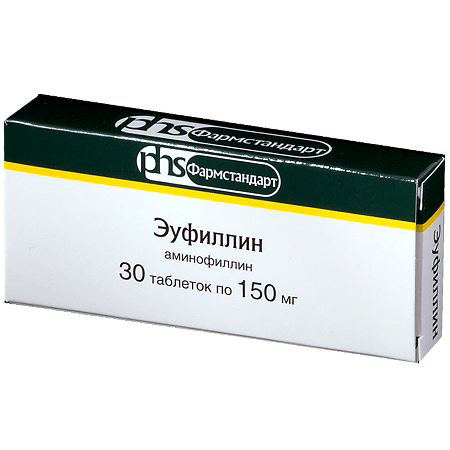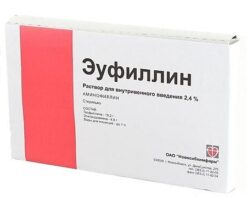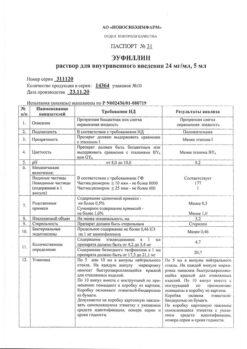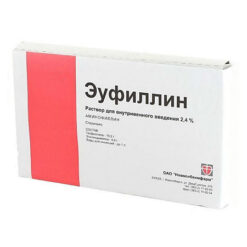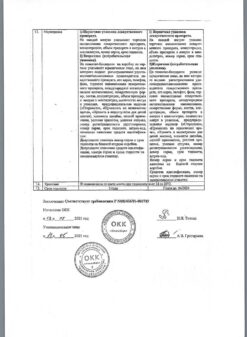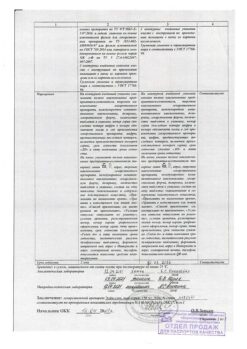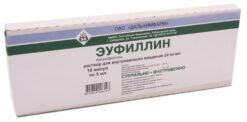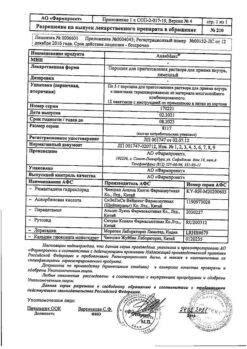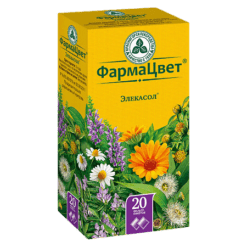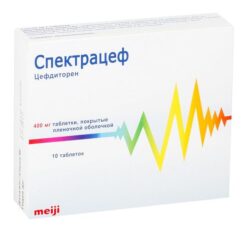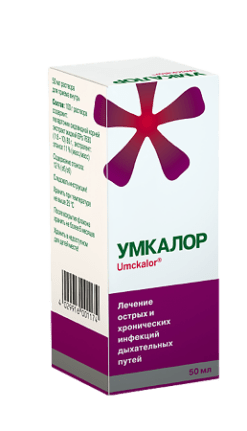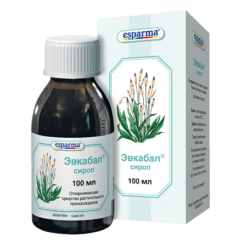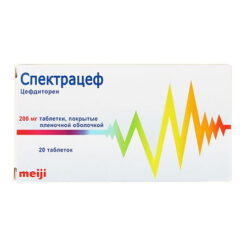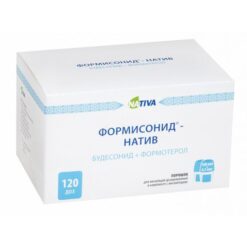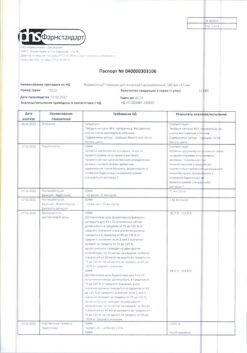No products in the cart.
Eufylline, tablets 150 mg 30 pcs
€1.24 €1.13
Description
Pharmacotherapeutic group
The bronchodilator
ATX code[R03DA05]
Pharmacological properties
Pharmacodynamics. Bronchodilator, xanthine derivative; inhibits phosphodiesterase, increases tissue accumulation of adenosine monophosphate (cAMP), blocks adenosine (purine) receptors; reduces calcium ion influx through cell membrane channels, reduces smooth muscle contractile activity.
It relaxes the bronchial musculature, stimulates the respiratory center, increases its sensitivity to carbon dioxide and improves alveolar ventilation, which ultimately leads to a reduction in the severity and frequency of apnea episodes. By normalizing respiratory function, it helps to saturate the blood with oxygen and reduce the concentration of carbon dioxide.
It has a stimulating effect on heart activity, increases the force and number of heartbeats, increases coronary blood flow and increases myocardial oxygen demand. It reduces the tone of the blood vessels (mainly the blood vessels of the brain, skin and kidneys). It has a peripheral venodilator effect, reduces pulmonary vascular resistance, lowers the pressure in the “small” circulatory circle. Increases renal blood flow, has a moderate diuretic effect. It dilates extrahepatic biliary tracts.
Stabilizes the membranes of mast cells, inhibits the release of mediators of allergic reactions.
Inhibits platelet aggregation (inhibits platelet-activating factor and prostaglandin E2 (PgE2), increases resistance to erythrocyte deformation (improves rheological properties of blood), reduces thrombosis and normalizes microcirculation.
It has a tocolytic effect, increases the acidity of gastric juice. When used in high doses it has epileptogenic effect.
Pharmacokinetics.
After oral administration is quickly and completely absorbed, bioavailability 90-100%. Food reduces the rate of absorption without affecting its magnitude (large volumes of liquid and proteins accelerate the process). The higher the dose taken, the lower the absorption rate. Time to reach maximum concentration is 1-2 hours. Distribution volume is in the range of 0.3-0.7 l/kg (30-70% of the “ideal” body weight), on average 0.45 l/kg. Binding to plasma proteins in adults is 60%, in patients with liver cirrhosis – 36%. It penetrates into breast milk (10% of the dose taken), through the placental barrier (concentration in fetal serum is slightly higher than in the serum of the mother).
The bronchodilator properties of aminophylline occur at concentrations of 10-20 µg/ml. Concentrations over 20 mg/ml are toxic. The excitatory effect on the respiratory center is realized at lower blood concentrations of 5-10 µg/ml.
It is metabolized at physiological pH values with release of free theophylline, which is further metabolized in the liver with the participation of several cytochrome P450 isoenzymes. As a result, caffeine and 1,3-dimethylureic acid (45-55%) are formed, which has pharmacological activity, but is 1-5 times inferior to theophylline. Caffeine is also an active metabolite, but it is formed in small amounts.
In children over 3 years of age and in adults (unlike in younger children) there is no caffeine cumulation phenomenon. Its half-life in children over 6 months is 3.7 hours, in adults 8.7 hours, in smokers (20-40 cigarettes per day) – 4-5 hours (after quitting smoking normalization of pharmacokinetics in 3-4 months); in adults with chronic obstructive pulmonary disease, “pulmonary” heart and pulmonary heart failure – over 24 hours. Metabolites are excreted by the kidneys.
Indications
Indications
Broncho-obstructive syndrome of any origin: bronchial asthma (drug of choice in patients with exercise-induced asthma and as an additional remedy for other forms), chronic obstructive pulmonary disease, pulmonary emphysema, chronic obstructive bronchitis, pulmonary hypertension, cor pulmonale, sleep apnea.
Pharmacological effect
Pharmacological effect
Pharmacotherapeutic group
Bronchodilator
ATX code [R03DA05]
Pharmacological properties
Pharmacodynamics. Bronchodilator, xanthine derivative; inhibits phosphodiesterase, increases the accumulation of adenosine monophosphate (cAMP) in tissues, blocks adenosine (purine) receptors; reduces the flow of calcium ions through the channels of cell membranes, reduces the contractile activity of smooth muscles.
Relaxes the muscles of the bronchi, stimulates the respiratory center, increases its sensitivity to carbon dioxide and improves alveolar ventilation, which ultimately leads to a decrease in the severity and frequency of apnea episodes. By normalizing respiratory function, it helps saturate the blood with oxygen and reduce the concentration of carbon dioxide.
It has a stimulating effect on the activity of the heart, increases the strength and number of heart contractions, increases coronary blood flow and increases the myocardial oxygen demand. Reduces the tone of blood vessels (mainly those of the brain, skin and kidneys). It has a peripheral venodilating effect, reduces pulmonary vascular resistance, and lowers pressure in the pulmonary circulation. Increases renal blood flow and has a moderate diuretic effect. Expands extrahepatic bile ducts.
Stabilizes mast cell membranes, inhibits the release of mediators of allergic reactions.
Inhibits platelet aggregation (suppresses platelet activating factor and prostaglandin E2 (PgE2), increases the resistance of red blood cells to deformation (improves the rheological properties of blood), reduces thrombus formation and normalizes microcirculation.
It has a tocolytic effect, increases the acidity of gastric juice. When used in large doses, it has an epileptogenic effect.
Pharmacokinetics.
After oral administration, it is quickly and completely absorbed, bioavailability is 90-100%. Food reduces the rate of absorption without affecting its magnitude (large volumes of liquid and proteins speed up the process). The higher the dose taken, the lower the absorption rate. Time to reach maximum concentration is 1-2 hours. The volume of distribution is in the range of 0.3-0.7 l/kg (30-70% of “ideal” body weight), with an average of 0.45 l/kg. The connection with plasma proteins in adults is 60%, in patients with liver cirrhosis – 36%. Penetrates into breast milk (10% of the dose taken), through the placental barrier (the concentration in the fetal blood serum is slightly higher than in the maternal serum).
Aminophylline exhibits bronchodilating properties in concentrations of 10-20 μg/ml. Concentrations above 20 mg/ml are toxic. The stimulating effect on the respiratory center is realized at a lower content of the drug in the blood – 5-10 mcg/ml.
Metabolized at physiological pH values with the release of free theophylline, which is further metabolized in the liver with the participation of several cytochrome P450 isoenzymes. As a result, caffeine and 1,3-dimethyluric acid (45-55%) are formed, which has pharmacological activity, but is 1-5 times inferior to theophylline. Caffeine is also an active metabolite, but is formed in small quantities.
In children over 3 years of age and in adults (unlike younger children), the phenomenon of caffeine accumulation is absent. Its half-life in children over 6 months is 3.7 hours, in adults 8.7 hours, in smokers (20-40 cigarettes per day) – 4-5 hours (after quitting smoking, pharmacokinetics normalize after 3-4 months); in adults with chronic obstructive pulmonary disease, pulmonary heart disease and pulmonary heart failure – over 24 hours. Metabolites are excreted by the kidneys.
Special instructions
Special instructions
Use with caution in severe coronary insufficiency (acute phase of myocardial infarction, angina pectoris), widespread atherosclerosis, hypertrophic obstructive cardiomyopathy, frequent ventricular extrasystoles, increased convulsive readiness, liver and/or renal failure, gastric and duodenal ulcers (history), recent bleeding from the gastrointestinal tract, uncontrolled hypothyroidism (possibility of cumulation) or thyrotoxicosis, with prolonged hyperthermia, gastroesophageal reflux, prostate hypertrophy, in elderly patients, in children (especially orally).
Correction of the aminophylline dosage regimen may be required for heart failure, liver dysfunction, chronic alcoholism, fever, and acute respiratory infections.
In elderly patients, a dose reduction may be required.
When replacing the used dosage form of aminophylline with another, clinical observation and monitoring of the concentration of theophylline in the blood plasma is necessary.
Aminophylline is not used simultaneously with other xanthine derivatives. During the treatment period, you should avoid eating foods containing xanthine derivatives (strong coffee, tea).
Use with caution simultaneously with anticoagulants, with other theophylline or purine derivatives.
Concomitant use with beta-blockers should be avoided.
Aminophylline should not be used simultaneously with glucose solution.
Active ingredient
Active ingredient
Aminophylline
Composition
Composition
1 tablet contains:
Active substance:
aminophylline 150 mg.
Excipients:
calcium stearate,
potato starch.
Pregnancy
Pregnancy
Theophylline penetrates the placental barrier.
The use of aminophylline during pregnancy may result in potentially dangerous concentrations of theophylline and caffeine in the blood plasma of the newborn. Newborns whose mothers received aminophylline during pregnancy (especially in the third trimester) require medical supervision to monitor possible symptoms of theophylline intoxication.
Theophylline is excreted in breast milk. When using aminophylline in a nursing mother during lactation, irritability may occur in the child.
Thus, the use of aminophylline during pregnancy and lactation (breastfeeding) is possible in cases where the expected benefit of therapy for the mother outweighs the potential risk for the fetus or child.
Contraindications
Contraindications
severe arterial hyper- or hypotension,
hypersensitivity to aminophylline and theophylline.
tachyarrhythmias,
peptic ulcer of the stomach and duodenum in the acute phase,
hyperacid gastritis,
severe impairment of liver and/or kidney function,
epilepsy,
hemorrhagic stroke,
hemorrhage in the retina of the eye,
simultaneous use with ephedrine in children,
children’s age (up to 3 years).
Side Effects
Side Effects
From the central nervous system: dizziness, sleep disturbances, anxiety, tremor, convulsions.
From the cardiovascular system: palpitations, heart rhythm disturbances; with rapid intravenous administration – the appearance of pain in the heart, decreased blood pressure, tachycardia (including in the fetus when taken in the third trimester of pregnancy), arrhythmias, decreased blood pressure, cardialgia, increased frequency of angina attacks.
From the digestive system: nausea, vomiting, gastroesophageal reflux, heartburn, exacerbation of peptic ulcer, diarrhea; with prolonged ingestion – anorexia.
From the urinary system: albuminuria, hematuria.
Allergic reactions: skin rash, itching, fever.
Metabolism: rarely – hypoglycemia.
Other: chest pain, tachypnea, flushing, albuminuria, hematuria, hypoglycemia, increased diuresis, increased sweating.
Interaction
Interaction
When used simultaneously with sympathomimetics, a mutual enhancement of action occurs; with beta-blockers and lithium preparations – the effect is mutually reduced. The intensity of action of aminophylline may decrease (due to an increase in its clearance) when used simultaneously with phenobarbital, rifampicin, isoniazid, carbamazepine, sulfinpyrazone, phenytoin, as well as in smokers.
The intensity of action of aminophylline may increase (due to a decrease in its clearance) when used simultaneously with antibiotics from the macrolide group, lincomycin, with quinolones, allopurinol, beta-blockers, cimetidine, disulfiram, fluvoxamine, hormonal contraceptives for oral administration, isoprenaline, viloxazine and with influenza vaccination.
Xanthine derivatives may potentiate hypokalemia caused by the action of β2-adrenergic receptor stimulants, corticosteroids and diuretics.
Antidiarrheal drugs and enterosorbents reduce the absorption of aminophylline.
Pharmaceutically incompatible with acid solutions.
Overdose
Overdose
In case of overdose, facial skin flushing, insomnia, motor agitation, anxiety, photophobia, anorexia, diarrhea, nausea, vomiting, pain in the epigastric region, gastrointestinal bleeding, tachycardia, ventricular arrhythmias, tremor, generalized convulsions, hyperventilation, and a sharp decrease in blood pressure are observed. In severe poisoning, epileptoid seizures may develop (especially in children without any warning signs), hypoxia, metabolic acidosis, hyperglycemia, hypokalemia, skeletal muscle necrosis, confusion, renal failure with myoglobinuria.
Treatment of overdose depends on the clinical picture and includes drug withdrawal, stimulation of its removal from the body (forced diuresis, hemosorption, plasma sorption, hemodialysis, peritoneal dialysis) and the prescription of symptomatic drugs. Diazepam (by injection) is used to relieve seizures. Barbiturates should not be used. In case of severe intoxication (eufillin content more than 50 g/l), hemodialysis is recommended.
Storage conditions
Storage conditions
In a place protected from light at a temperature of 10 to 25C.
Shelf life
Shelf life
5 years
Manufacturer
Manufacturer
Pharmstandard-Leksredstva, Russia
Additional information
| Shelf life | 5 years |
|---|---|
| Conditions of storage | In the dark place at a temperature of 10 to 25C. |
| Manufacturer | Pharmstandard-Leksredstva, Russia |
| Medication form | pills |
| Brand | Pharmstandard-Leksredstva |
Other forms…
Related products
Buy Eufylline, tablets 150 mg 30 pcs with delivery to USA, UK, Europe and over 120 other countries.

